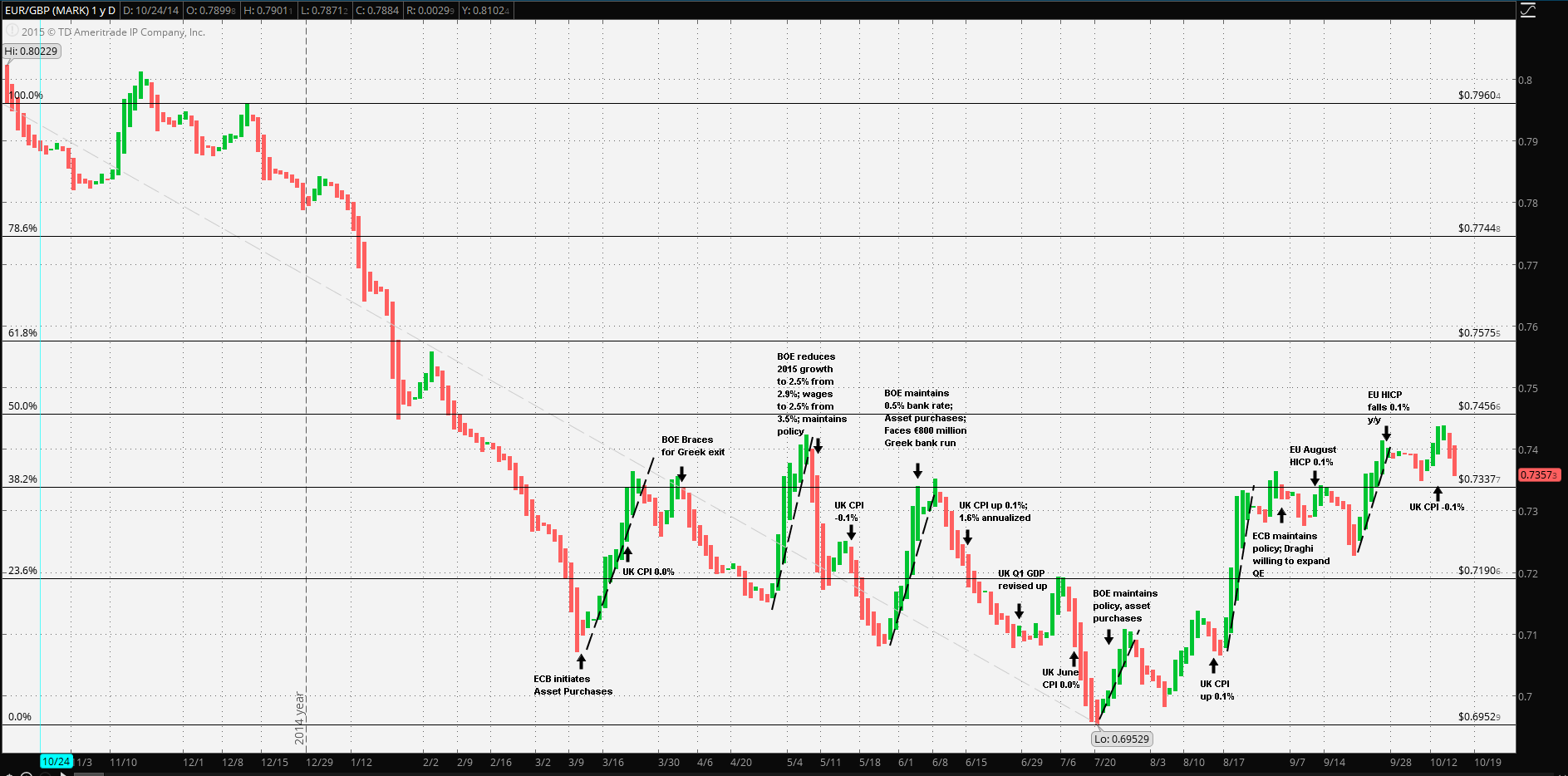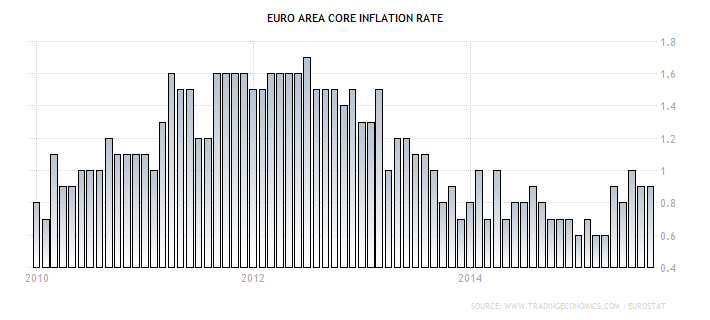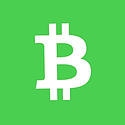
As a member of the EU the UK imports the bulk of its goods from its EU partners, which naturally includes the Eurozone. Of the UK’s 15 primary import origination, over 75% are fellow EU member states, and 92% of those are Eurozone members. The Eurozone is still struggling with disinflation if not outright deflation. The effect this trade is having on UK import prices is clear. Import prices have steadily declined from early 2014 to the present, coinciding with the steady weakening of the Euro vs the Pound Sterling.

Recently, it seems as though the ECB has been signaling, perhaps as a warning against currency manipulations or perhaps as an indication that the current QE program is not adequate enough. For example, a the 3 September ECB Governing Council press conference, ECB President Draghi emphasizedi that the program would continue until September 2016 or “...beyond if necessary... ...The information available indicates a continued, though somewhat weaker, economic recovery and a slower increase in inflation rates compared with earlier expectations... ...there are downside risks...” Mr. Draghi went on to note that it was possible that inflation rates could drop below zero in the Eurozone before reversing. Specifically he said “...We may see negative numbers of inflation in the coming months: is that deflation?... ...The Governing Council tends to think that these are transitory effects mostly due to oil-price effects. However, as I said before, we’ll closely monitor all incoming information and the Governing Council wanted to emphasize in the discussion we had today its willingness to act, its readiness to act and its capacity to act, its ability to act...”
One of the Governing Council’s decisions at the meeting was to raise the asset purchase ceiling to 33% of each issue from 25%.
These comments were followed on 15 September at the annual Kansas City Federal Reserve Symposium when ECB Vice President Vitor Constancio compared the current asset purchase program to other programs as a percentage of GDPii: “...The total amount that we have purchased represents 5.3 percent of the GDP of the euro area, whereas what the Fed has done represents almost 25 percent of the U.S. GDP, what the Bank of Japan has done represents 64 percent of the Japanese GDP and what the U.K. has done 21 percent of the UK’s GDP...”
The case could be made that the disinflationary trend is not exactly being caused by declining energy prices, but rather is contributing to other, already existing disinflationary factors.

The UK is also experiencing low CPI however, the Pound Sterling is persistently strong against the majors. From the start of the year, the UK economy had been growing strongly enough to cause the BOE to consider a rate increase by year’s end. However, February’s inflation data registered 0.0%, a record low at that time and down from January’s 0.3% rateiii. Within a week, revised 2014 Q4 GDP indicated better than expected growthiv. Another indication of an imbalance was a record high current account deficit which would indicate that the import value of goods and services had exceeded the value of those exportedv. Minutes from the March meeting noted that the, “...current account deficit was large and could, in adverse circumstances, trigger the deterioration in market sentiment towards the United Kingdom... ...The committee agreed to keep their assessment of this risk under close review and would monitor the maturity and liquidity of the financing of the deficit...”
The pieces seem to fit together. The ‘lion’s share’ of imports are from the Eurozone; a GBP which had greatly appreciated vs the Euro; reasonably strong domestic spending, a record high current account deficit and virtually zero price inflation. If so, this creates a ‘conundrum’ for the BOE: if the BOE bias is towards a rate increase, while the ECB bias is towards a weaker Euro, the stronger Pound Sterling vs a weaker Euro would only serve to depress import prices, in particular, goods and services, further increasing capital outflows.
However, UK economic data which followed was inconsistent, particularly in GDP growthvi. The situation for the BOE paralleled that of the US Fed: sometimes strong data, sometimes weak, high employment along with low wage and price growth. The last straw for a delay in benchmark rate increases by the BOE as well as the US Fed was the collapse of global commodity prices as well as the contraction in the Chinese economy. The uncertainty of the global effect has put the BOE on hold, however, the global effect may further deflate the Eurozone economy causing the ECB to expand their QE. On 15 October, ECB Governing Council member Ewald Nowotny had stated in a speechvii that, “...we need stronger economic growth... ...but it is quite obvious that in the current macroeconomic situation additional sets of instruments are necessary...”, which may possibly be interpreted as a further indication towards expanding QE.
Since the 52 week, 20 July low of £0.69529, the Euro has gained on the pound by about 6.23% to £0.7337. With the BOE most likely on hold until 2016, and a weakening global economy, it’s reasonable to expect a further weakening of Euro.
Risk warning: Spreadbetting, CFD trading and Forex are leveraged. This means they can result in losses exceeding your original deposit. Ensure you understand the risks, seek independent financial advice if necessary. The value of shares and the income from them may go down as well as up. Nothing on this website constitutes a solicitation or recommendation to enter into any security or investment.
Recommended Content
Editors’ Picks
AUD/USD extends gains due to improved risk appetite

The Australian Dollar maintained its winning streak for the fourth consecutive session on Monday, buoyed by a hawkish sentiment surrounding the Reserve Bank of Australia. This optimism bolsters the strength of the Aussie Dollar, providing support to the AUD/USD pair.
USD/JPY snaps three-day losing streak above 153.50, Yellen counsels caution on currency intervention

The USD/JPY pair snap a three-day losing streak during the Asian trading hours on Monday. The uptick of the pair is bolstered by the modest rebound of the US Dollar and US Treasury Secretary Janet Yellen’s comments on potential Japanese interventions last week.
Gold price rebounds on downbeat NFP data, softer US Dollar

Gold price snaps the two-day losing streak during the Asian session on Monday. The weaker-than-expected US employment reports have boosted the odds of a September rate cut from the US Federal Reserve. This, in turn, has dragged the US Dollar lower and lifted the USD-denominated gold.
Bitcoin Cash could become a Cardano partnerchain as 66% of 11.3K voters say “Aye”

Bitcoin Cash is the current mania in the Cardano ecosystem following a proposal by the network’s executive inviting the public to vote on X, about a possible integration.
Week ahead: BoE and RBA decisions headline a calm week

Bank of England meets on Thursday, unlikely to signal rate cuts. Reserve Bank of Australia could maintain a higher-for-longer stance. Elsewhere, Bank of Japan releases summary of opinions.